
views
X
Expert Source
Olivia ChoongPlant & Gardening Specialist
Expert Interview. 3 September 2021.
After you've amended the soil's nutrient content, you can plant your tomatoes by spacing them out properly, driving stakes to help support them, and watering them to help them settle into the soil.
Tilling the Soil
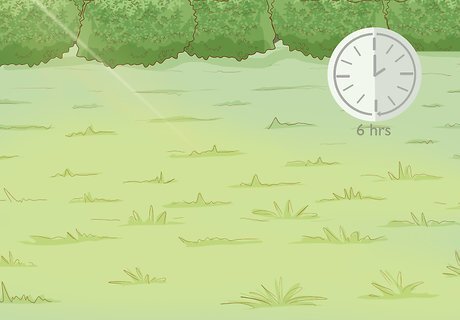
Choose a location that gets at least 6 hours of direct sun. When you're choosing an area for your tomato garden, make sure it gets enough sunlight to allow the plants to grow and produce. Avoid placing your tomato garden next to a building or under a tree that could block sunlight for parts of the day. Look for an area that has decent drainage and doesn't flood every time it rains.
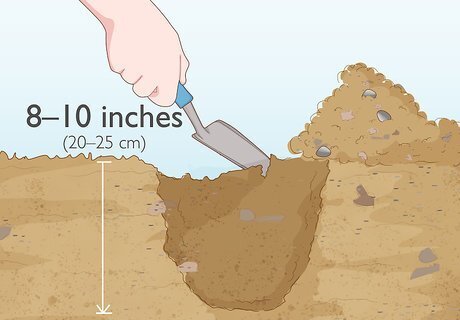
Dig about 8–10 inches (20–25 cm) down into the soil. Use a shovel or a tiller to dig up the dirt where you plan to place your garden so it will be better suited for your tomato plants. Dig deep enough to remove any grasses or plants and their root systems from the top of the soil. Wait until the ground is dry before you start digging.
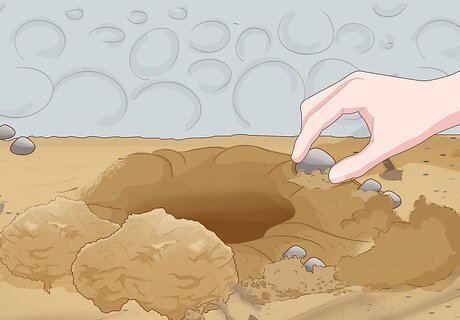
Remove any rocks or debris that you find in the soil. Look for sticks, broken roots, or any other types of debris while you dig up the soil. Take out anything that isn't dirt from the garden plot. Use a garden hoe to scrape through the dirt and look for sticks or debris that you can remove.Tip: Pull out any root systems from grasses or plants that were above the soil so they don't grow back in your garden.
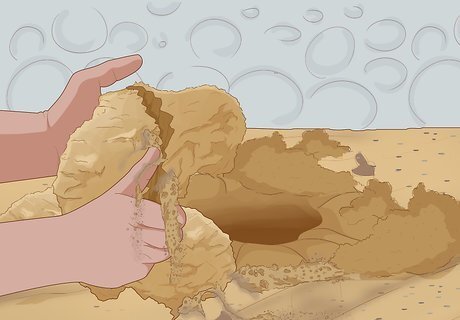
Break up large clods of soil. Use your hands or a garden hoe to break up hard clumps of earth into softer dirt. Large clods of tough soil can make it harder for the roots of your tomato plants to penetrate into the ground when you plant them. Use a garden rake to sift through the soil and break up any large clumps.
Adjusting the pH and Adding Nutrients

Test the soil to find its nutrient and pH levels. Knowing the pH level of your soil is important because different plants thrive under different pH levels. It's also helpful for you to know the nutrient levels so you know what you need to add to the soil to help the tomato plants thrive. Use a commercial testing kit to collect and test a sample of the soil where you plan to plant your tomatoes. Tomatoes grow best in slightly acidic soil, with the optimum pH level being between 6.2 and 6.8. Soil that falls below 6.0 is too acidic for tomato plants to thrive. An even balance of nitrogen, phosphorus, and potassium is necessary for your tomato plants to produce lots of healthy fruit. Too much of 1 nutrient can affect the health of your tomato plants.
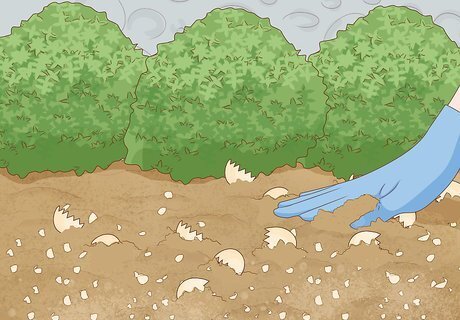
Adjust the pH with eggshells or coffee so it's between 6.2 and 6.8. If the pH of your soil is below 6.2, mix in crushed eggshells at a ratio of 1 pound (0.45 kg) for every 100 square feet (9.3 m). For soil that has a pH above 6.8, you need to make it more acidic. Mix together equal parts water and cold coffee in a water can and apply it to the soil. For example, if you have a tomato garden that is about 20 square feet (1.9 m), then mix in about .2 pounds (0.091 kg) of eggshells. Turn the soil over and mix it up after you apply the eggshells or coffee mixture. Retest the soil to see if the pH level is between 6.2 and 6.8 before you plant your tomato plants.

Mix in a natural source of nitrogen into the soil if needed. Your soil needs to have an even ratio of nitrogen, potassium, and phosphorus for your tomato plants. If you have a low amount of nitrogen, add in a natural source, then retest the soil to make sure the levels are even. Combine the nitrogen source with the top layer of soil and compost by mixing it together with a shovel. Natural sources of nitrogen include alfalfa meal, blood meal, feather meal, and fish meal. You can also add artificial nitrogen fertilizers like ammonium nitrate or ammonium sulfate.
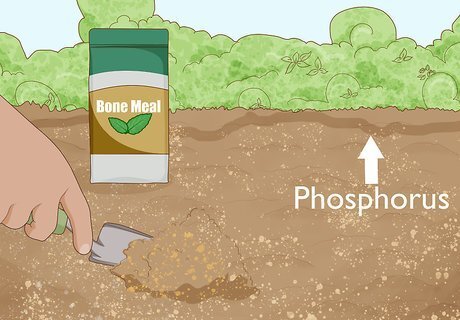
Raise the phosphorus content by adding bone meal to the soil. Bone meal is a great organic source of phosphorus that you can add to your soil raise the levels of that nutrient. Mix in the bone meal with the soil then retest it to make sure the levels are even with the nitrogen and potassium levels. Artificial phosphorus fertilizers include rock phosphate and superphosphate. You can find bone meal and phosphorus fertilizers at garden supply stores, nurseries, and online.
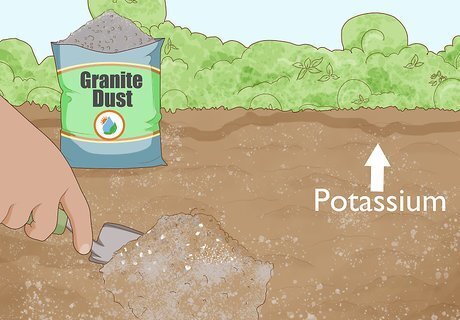
Increase the levels of potassium with wood ash or granite dust. If you need to elevate your potassium levels so they're even with the levels of nitrogen and phosphorus in the soil, add some wood ash or granite dust and mix it in with the top layer of soil. After you combine it with the soil, retest it to make sure the levels are even. You can use potassium sulfate or rock sand as artificial fertilizers that will raise the potassium content of your soil. Find wood ash, granite dust, or artificial potassium fertilizers at local nurseries, home improvement stores, or online.
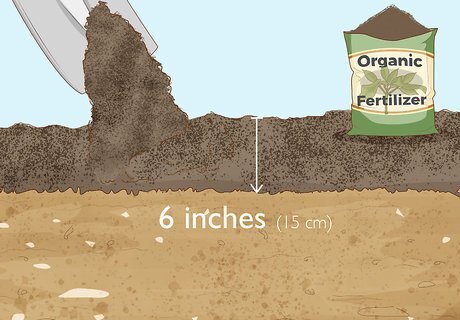
Place any nutrients you add into the top 6 inches (15 cm) of soil. No matter what fertilizers or nutrients you plan to add to your soil to prepare it for tomato plants, you need to add them to the top layer of the soil that you tilled for your garden. Mix in the compost or nutrients well with the soil so the roots of the tomato plants can start to absorb them as soon as you plant them. Turn the dirt over with your shovel to help combine the nutrients, compost, and soil.
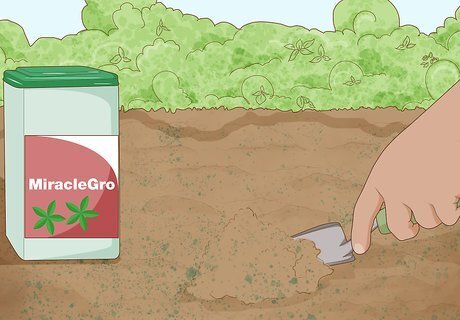
Mix in an artificial fertilizer for an easy way to increase the nutrient content. If your soil is lacking in nutrients, you can add a continuous-release fertilizer that will provide the nutrients your tomato plants need. Artificial fertilizers are less natural and organic, but they quickly raise the nutrient content of your soil. Mix in the fertilizer with the top layer of soil and compost. Choose a fertilizer that has an even ratio of potassium, phosphorus, and nitrogen for your tomato plants. You can find fertilizers at garden supply stores, plant nurseries, or online. Popular continuous-release fertilizers include Miracle-Gro, Tomato-tone, and Fox Farm Tiger Bloom. Add the artificial fertilizer according to the directions on the packaging. Different fertilizers have different concentrations and application methods.
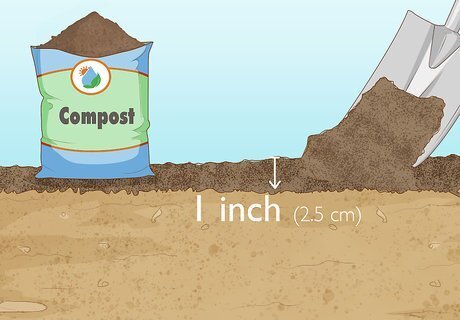
Add compost to help the soil retain moisture and nutrients. The compost will add a small but continuous amount of nutrients and will help the soil hold water and keep the roots from drying out. Cover the top of the soil with a 1 inch (2.5 cm) layer of compost, then mix it into the soil. Compost will also help any fertilizer that you add stay in the soil until it's needed by your tomato plants. You can find compost at garden supply stores, nurseries, or online.Tip: Choose a compost that includes minerals like granite dust and composted bark which will help your tomato plants adjust to the soil.
Planting the Tomatoes
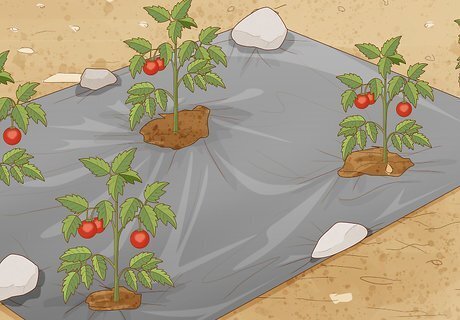
Keep the soil covered with black plastic until you're ready to plant. A couple of weeks before you plant your tomatoes, you can start getting the soil temperature to heat up so there's less of a shock to the plants when you put them in the soil. Place a layer of black plastic over the tilled dirt so it can absorb the heat from the sun and warm up the ground. Remove the black plastic when you're ready to plant your tomato plants. Anchor the black plastic at the corners with rocks, bricks, or any other object heavy enough to keep it held in place. You can find rolls of black plastic at home improvement stores, garden nurseries, or online.
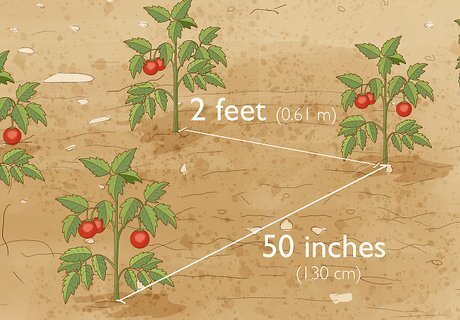
Space the plants 2 feet (0.61 m) apart in rows 50 inches (130 cm) apart. You need to leave enough space around each plant to allow you to water them and pull out any weeds that grow. Align your plants into rows that are about 50 inches (130 cm) apart from each other so you can more easily navigate the garden when you harvest, water, and weed it. Make sure the rows are even so they're easier to water and access.
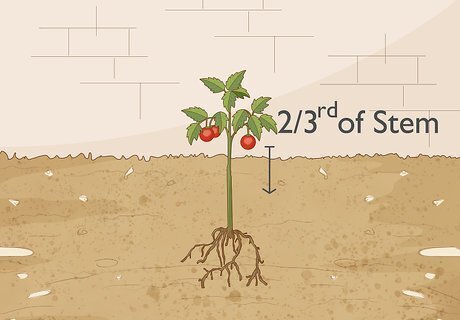
Bury the plant so about two-thirds of the stem is covered. Burying much of the stem of the tomato plants will allow them to be stronger and better able to form new root systems as they adapt to the new soil. Dig a small hole into the soil, place the plant into it, and cover up the stem so that only about ⅓ of the tomato plant is exposed. Don't pile the soil up around the stem. Instead, dig a hole deep enough to cover the plant.

Place 1 stake in the soil about 2 inches (5.1 cm) away from each plant. Tomato plants need a support system to keep them from falling over or drooping toward the ground. To avoid damaging the roots of the plants later, it's best to drive stakes into the ground when you plant the tomatoes. Use a 1 inch (2.5 cm) by 1 inch (2.5 cm) stake that is about 4 feet (1.2 m) tall. Drive the stake at least 6–8 inches (15–20 cm) deep into the ground. You don't need to tie the plants to the stakes until they're larger.
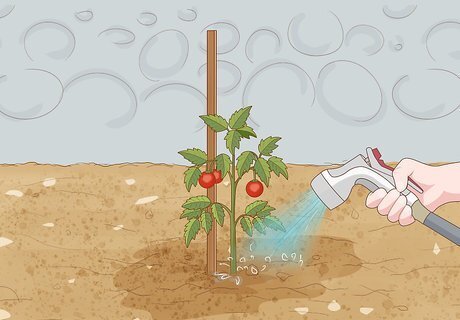
Water the soil as soon as you plant the tomatoes. When you're finished planting all of your tomato plants into the soil, you need to water them immediately to help them settle in. Use a light sprinkler or a watering can so you don't bend or knock over any of the plants with the water. Thoroughly water the entire garden. Don't oversaturate or flood the garden. Add enough water to soak the top layer of soil.Tip: If a plant becomes more exposed after you water it, add more soil to make sure ⅔ of the stem is covered up.


















Comments
0 comment